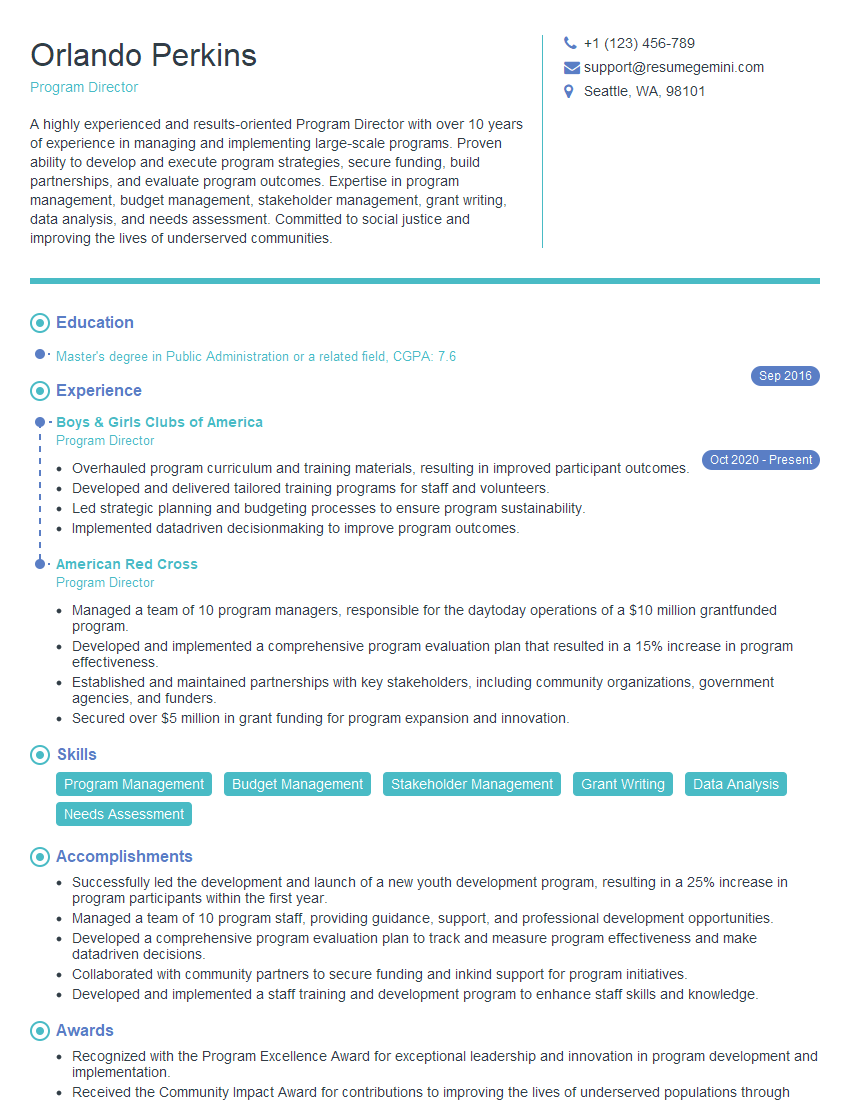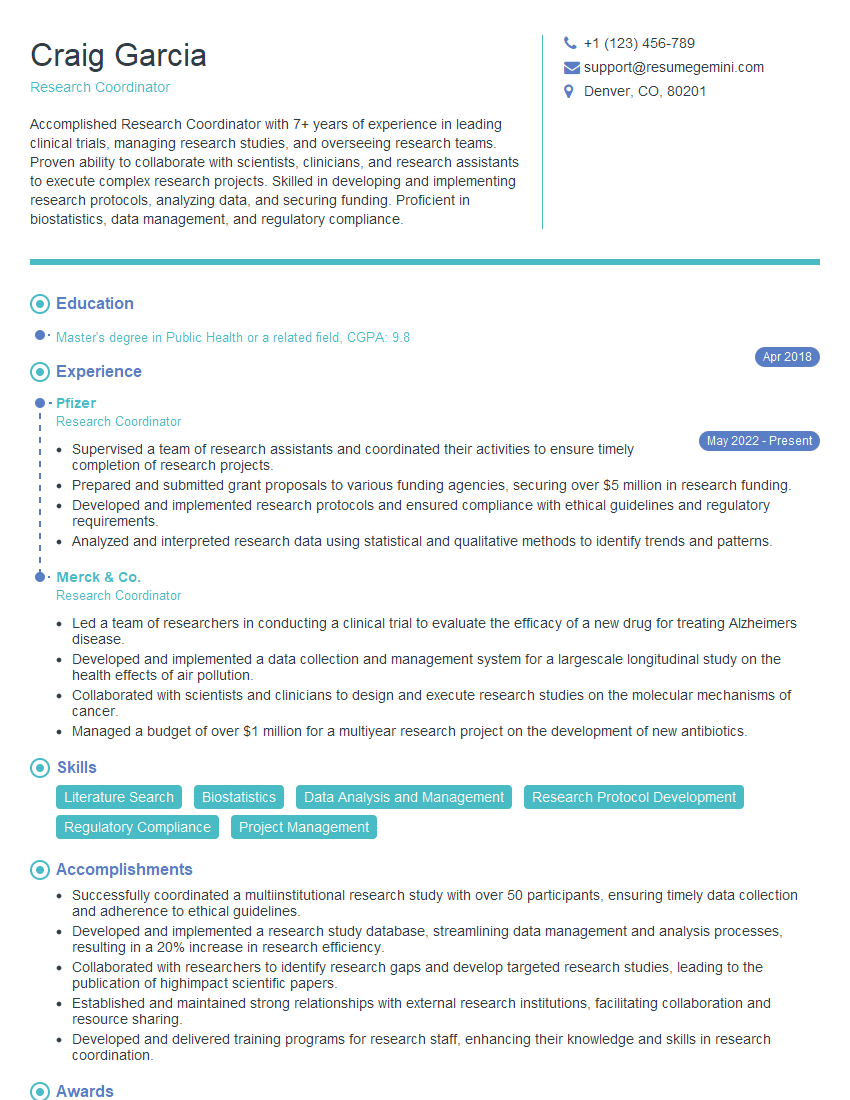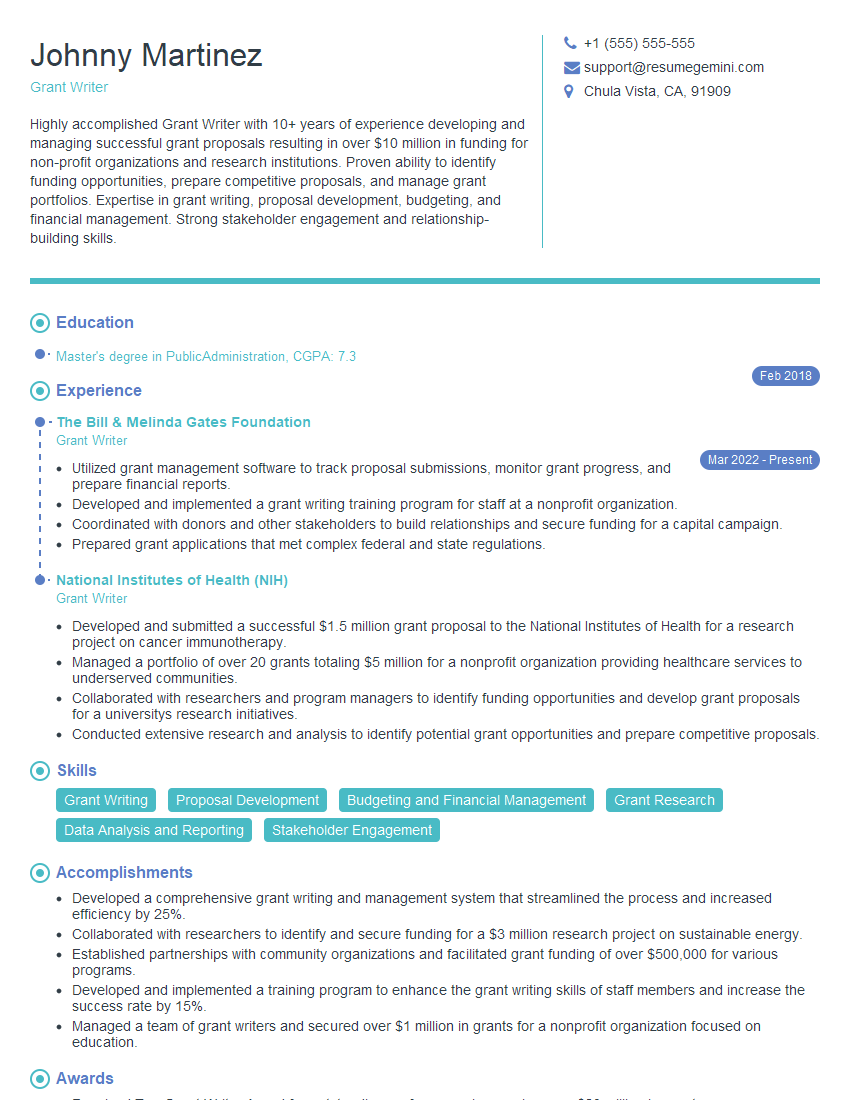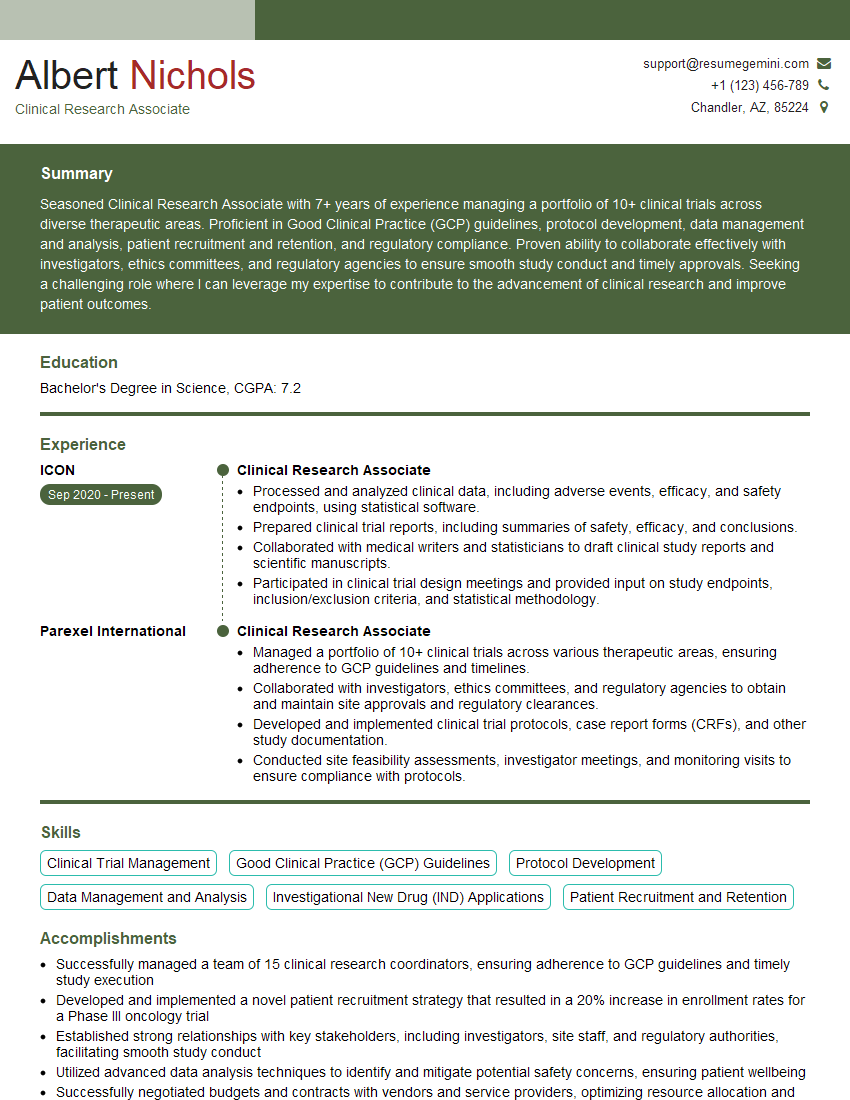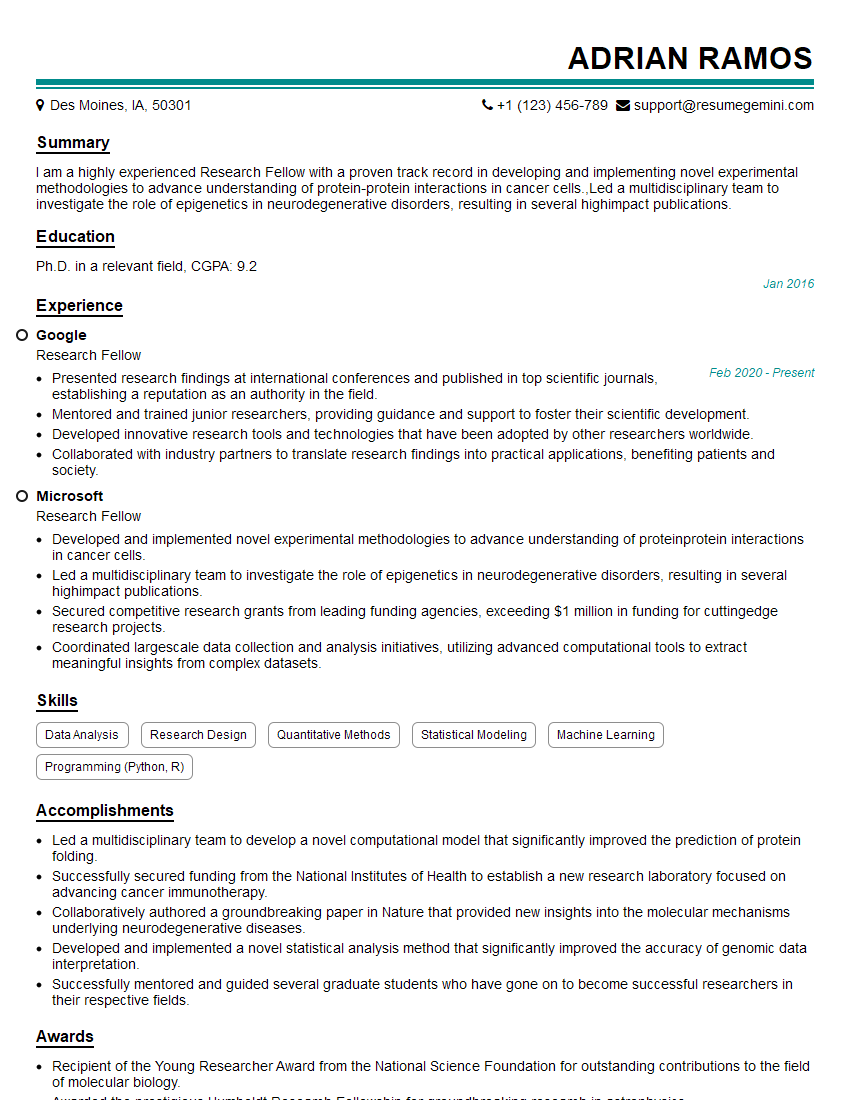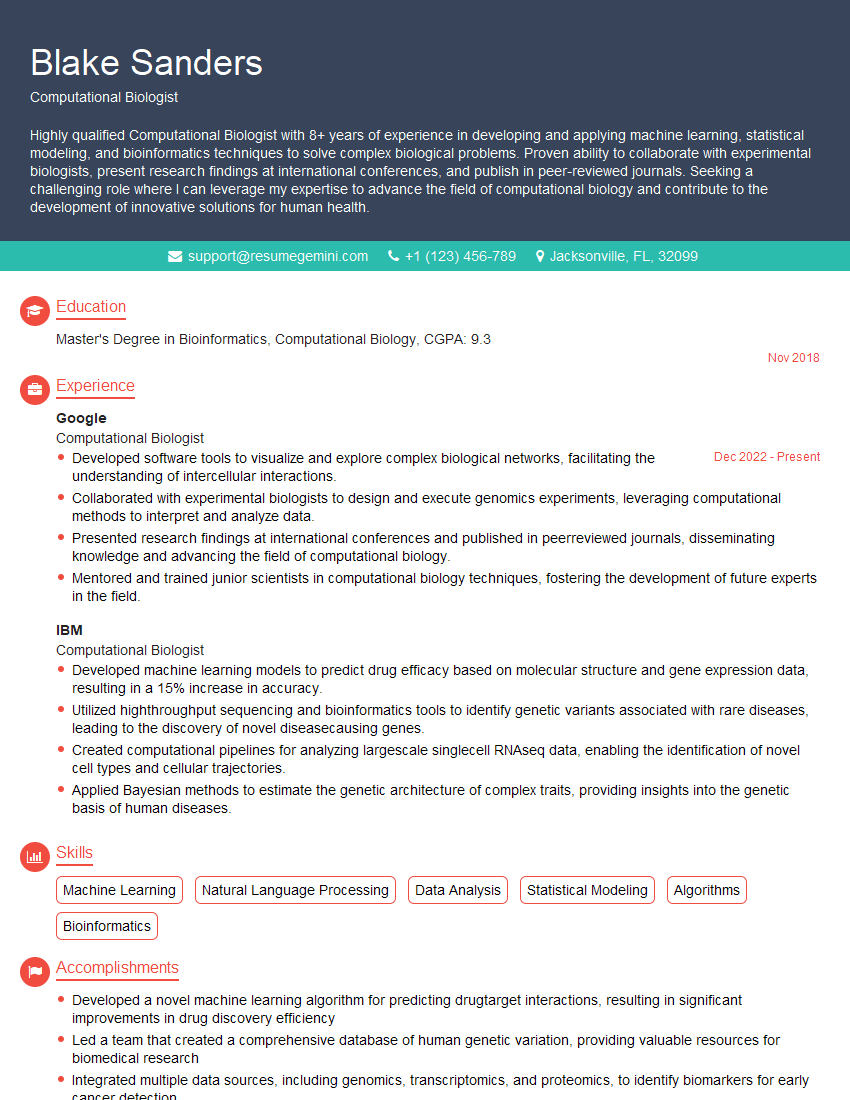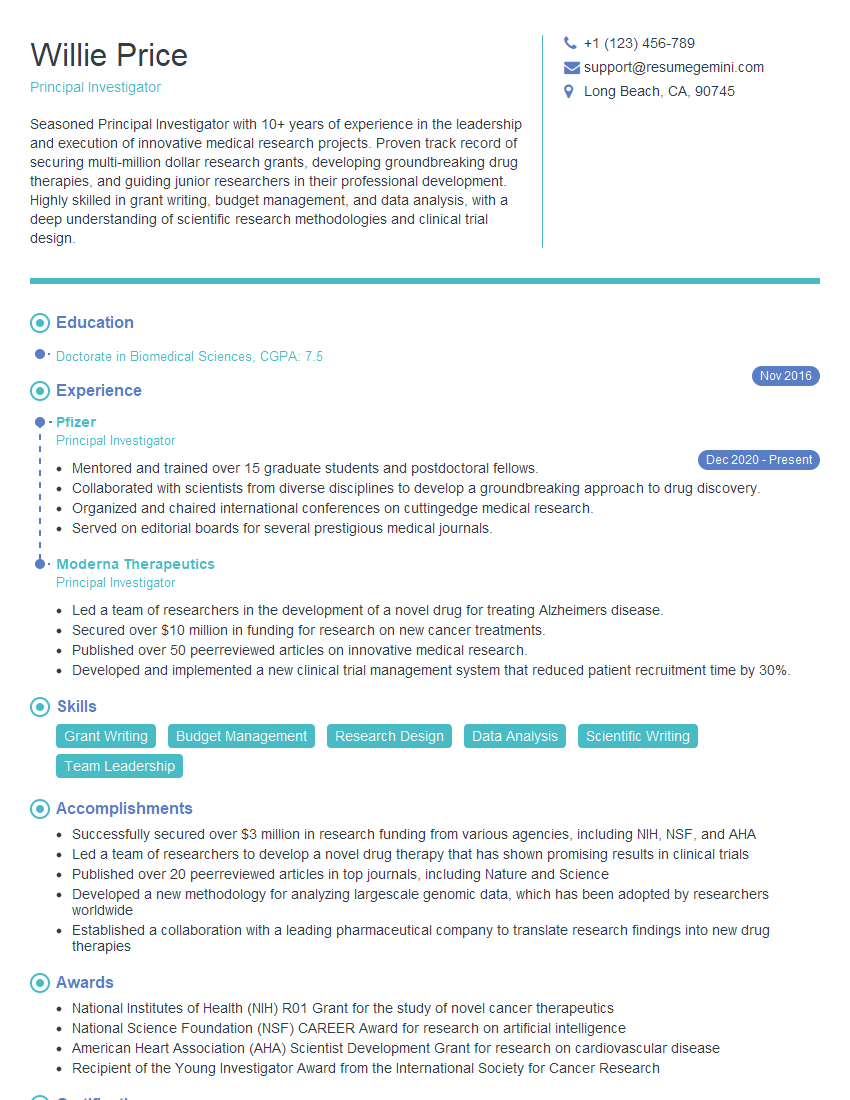Preparation is the key to success in any interview. In this post, we’ll explore crucial Interdisciplinary Collaboration and Research interview questions and equip you with strategies to craft impactful answers. Whether you’re a beginner or a pro, these tips will elevate your preparation.
Questions Asked in Interdisciplinary Collaboration and Research Interview
Q 1. Describe your experience in fostering collaboration among diverse research teams.
Fostering collaboration among diverse research teams requires a multifaceted approach centered around building trust, establishing clear communication channels, and creating a shared vision. It’s like orchestrating a symphony – each instrument (researcher/discipline) is unique, but together they create something beautiful and impactful.
- Shared Goals and Objectives: I begin by clearly defining the overarching research goals and ensuring every team member understands their contribution to the bigger picture. This involves collaborative goal setting workshops and regular check-ins to ensure alignment.
- Respect for Diverse Expertise: I actively promote mutual respect and appreciation for the unique skills and perspectives each discipline brings. This involves showcasing individual contributions and celebrating successes together.
- Open Communication: Regular team meetings, both formal and informal, are crucial. I encourage open dialogue, brainstorming sessions, and constructive feedback, making sure everyone feels heard and valued.
- Conflict Resolution Mechanisms: Establishing clear protocols for addressing conflicts early is vital. This might involve mediation, facilitated discussions, or the use of collaborative problem-solving techniques.
- Cross-Training and Knowledge Sharing: I facilitate opportunities for team members to learn from each other’s expertise through workshops, presentations, and informal knowledge-sharing sessions. This helps bridge disciplinary gaps and fosters a stronger sense of shared understanding.
For example, in a project investigating the impact of climate change on coastal communities, I’ve successfully integrated climate scientists, sociologists, economists, and geographers by clearly defining our shared goal of providing actionable recommendations for policymakers. This involved regular joint workshops, cross-disciplinary presentations, and a collaboratively written final report that integrated insights from all perspectives.
Q 2. Explain how you approach resolving conflicts arising from differing research methodologies.
Differing research methodologies can sometimes lead to conflict. My approach focuses on understanding the underlying rationale, finding common ground, and integrating diverse approaches where possible. Think of it as a culinary fusion – each ingredient has its own unique flavor profile, but together they create a more complex and delicious dish.
- Understanding Perspectives: The first step is to understand why different methodologies are being employed. This involves respectful dialogue to uncover the strengths and limitations of each approach.
- Identifying Common Ground: Often, despite methodological differences, there’s a shared research question or overall objective. Focusing on these shared aspects helps facilitate a collaborative spirit.
- Triangulation and Integration: Where possible, I encourage the use of triangulation – using multiple methodologies to confirm or refute findings. This approach strengthens the overall validity and reliability of the research.
- Methodological Complementarity: I strive to show how different methodologies complement each other rather than compete. For instance, qualitative insights can enrich quantitative data, and vice versa.
- Compromise and Negotiation: Sometimes, compromises need to be made. This requires open communication, mutual respect, and a willingness to adapt and adjust research plans.
In one project, a quantitative team favored large-scale surveys, while a qualitative team preferred in-depth interviews. Through open discussions, we realized that the survey could provide a broad overview, while the interviews could offer richer contextual understanding. We integrated both approaches to create a more comprehensive analysis.
Q 3. How do you integrate findings from multiple disciplines to achieve a unified research outcome?
Integrating findings from multiple disciplines to achieve a unified research outcome requires a structured approach focused on identifying common themes, synthesizing information, and building a cohesive narrative. This is akin to assembling a jigsaw puzzle – each piece (finding) seems disparate initially, but when brought together, it reveals a complete picture.
- Conceptual Framework: Developing a strong conceptual framework that integrates the various disciplines is crucial. This framework acts as a unifying lens through which all findings are interpreted.
- Data Synthesis: Employing appropriate data synthesis techniques (meta-analysis, thematic analysis, narrative synthesis) allows for the integration of diverse data types and research findings.
- Cross-Disciplinary Interpretation: Analyzing findings from different perspectives enhances the depth and breadth of interpretation. This necessitates a collaborative discussion among team members.
- Unified Narrative: The final report or presentation should weave together the findings from all disciplines into a coherent and compelling narrative. The focus should be on the overall implications and conclusions rather than isolated findings.
- Visual Representation: Using visual tools like concept maps, flow charts, and integrated figures can greatly assist in presenting a unified and accessible overview of the research findings.
In a study on urban resilience, we integrated findings from urban planning, sociology, engineering, and environmental science. By using a shared framework focusing on social-ecological systems, we were able to present a unified view of how urban areas respond to environmental stress and social change.
Q 4. What strategies do you employ to ensure effective communication within an interdisciplinary team?
Effective communication is the cornerstone of successful interdisciplinary collaboration. It’s about establishing a shared language and fostering open dialogue. Think of it as a well-oiled machine – each part needs to communicate smoothly with the others for optimal function.
- Regular Meetings: Scheduled meetings, with clearly defined agendas, keep everyone informed and engaged.
- Shared Communication Platforms: Utilizing project management tools (e.g., Trello, Asana) or collaborative platforms (e.g., Google Docs, SharePoint) improves information sharing and accessibility.
- Clear Communication Protocols: Establishing standardized communication formats (e.g., regular progress reports, presentation templates) maintains consistency and clarity.
- Active Listening and Feedback: Encouraging open dialogue, active listening, and constructive feedback builds trust and ensures mutual understanding.
- Visual Communication: Utilizing visual aids (charts, graphs, infographics) helps in bridging communication gaps across disciplines.
In a recent project, we used a shared online platform to track progress, share documents, and facilitate discussions. This platform enabled seamless communication across geographical boundaries and helped to avoid information silos.
Q 5. Describe a time you had to negotiate competing priorities within an interdisciplinary project.
Negotiating competing priorities is an inevitable part of interdisciplinary research. My approach emphasizes finding solutions that maximize overall project goals while respecting individual team member’s concerns. It’s a bit like navigating a busy intersection – you need skillful maneuvering to avoid collisions and reach your destination.
In one project, the engineering team prioritized developing a sophisticated technical model, while the social science team prioritized extensive community engagement. These priorities initially seemed contradictory. To resolve this, we used a phased approach. The engineering team initially developed a basic model, allowing the social science team to conduct community engagement parallel to the model’s refinement. This ensured both priorities were met, leading to a more holistic outcome.
This involved:
- Open and Honest Discussion: Clearly articulating each team’s priorities and concerns.
- Prioritization Matrix: Creating a matrix to rank priorities based on their impact on the overall research goals.
- Finding Synergies: Identifying ways in which different priorities could mutually support each other.
- Compromise and Flexibility: Acknowledging the need for compromise and demonstrating flexibility in scheduling and resource allocation.
Q 6. How do you identify and address potential ethical challenges in interdisciplinary research?
Addressing ethical challenges is paramount in interdisciplinary research, as the involvement of multiple disciplines can introduce complex ethical considerations. It’s about ensuring research integrity, protecting participants, and upholding ethical standards across all involved disciplines. Think of it as a safety net – multiple layers of protection are needed to safeguard the research process.
- Ethical Review Boards: Engaging multiple ethical review boards or a single board with interdisciplinary expertise to assess the ethical implications of the research design and procedures.
- Data Security and Privacy: Implementing robust data security and privacy measures to protect participant confidentiality and comply with relevant regulations.
- Informed Consent: Ensuring all participants provide informed consent, clearly understanding the research purpose, procedures, and potential risks.
- Conflict of Interest Management: Developing clear strategies for identifying and managing potential conflicts of interest among researchers with diverse affiliations and funding sources.
- Cultural Sensitivity: If the research involves diverse populations, incorporating cultural sensitivity and respecting cultural norms is crucial.
- Open Communication about Ethical Concerns: Fostering an open environment where team members feel comfortable raising and discussing ethical concerns.
In a study involving Indigenous communities, we meticulously followed ethical guidelines, including obtaining community consent, ensuring cultural sensitivity, and ensuring all research outputs were accessible and beneficial to the community.
Q 7. What are the key benefits and challenges of interdisciplinary research?
Interdisciplinary research offers significant benefits but also presents unique challenges. It’s a double-edged sword – the potential rewards are immense, but navigating the complexities requires careful planning and execution.
Benefits:
- Holistic Understanding: Provides a more comprehensive and nuanced understanding of complex phenomena than single-discipline approaches.
- Innovation and Creativity: Fosters innovation and creativity through the integration of diverse perspectives and methodologies.
- Real-World Impact: Often leads to more impactful and relevant research outcomes with greater potential for real-world application.
- Enhanced Problem-Solving: Enhances problem-solving capabilities by bringing different perspectives and analytical tools to bear on research problems.
Challenges:
- Communication Barriers: Differences in disciplinary language, theories, and methodologies can create communication barriers.
- Integration Difficulties: Integrating findings from multiple disciplines can be challenging, requiring careful synthesis and interpretation.
- Conflict and Power Dynamics: Differences in disciplinary values, priorities, and power dynamics can lead to conflict and tension.
- Resource Intensive: Interdisciplinary research often requires more resources (time, funding, personnel) compared to single-discipline projects.
- Collaboration Complexity: Managing collaborations among researchers from different institutions and backgrounds can be complex.
Effectively navigating these challenges requires a strong emphasis on communication, collaborative leadership, and a shared commitment to achieving a common research goal.
Q 8. Explain how you manage data integration and analysis across different disciplines.
Data integration and analysis across disciplines requires a structured approach. It’s like assembling a complex jigsaw puzzle where each piece represents data from a different field. First, we need to define a common data model – a shared language for all data types. This might involve standardizing units, creating ontologies (formal representations of knowledge), or using common data formats like CSV or JSON. Then, data cleaning and transformation are crucial to ensure consistency and accuracy. This often involves handling missing data, dealing with different data formats, and potentially creating new variables through data manipulation.
Next, we employ appropriate analytical methods. This may involve statistical modeling, machine learning algorithms, or qualitative analysis techniques, depending on the nature of the data and the research question. For instance, in a project combining environmental science and economics, we might use statistical modeling to analyze the relationship between pollution levels and economic activity, while employing qualitative methods to understand public perceptions of environmental policies. Finally, effective visualization tools are critical to present findings clearly and communicate insights across disciplines. Tools like interactive dashboards, infographics, and even carefully chosen charts can make complex information digestible for diverse audiences.
Q 9. How do you evaluate the success of an interdisciplinary research project?
Evaluating the success of an interdisciplinary project isn’t simply about publication numbers or grant funding. It’s a multifaceted process. We use a balanced scorecard approach, assessing success across several dimensions. First, we evaluate the project’s scientific merit, examining the rigor of the methodology, the quality of the data analysis, and the originality of the findings. Did we achieve our primary research objectives? Second, we assess its impact, considering its influence on theory, practice, and policy. Did the research influence existing theories in one or more fields? Did it translate into new applications or public policy changes? We also evaluate the collaborative aspects – did the team successfully integrate diverse perspectives, leading to a more robust and innovative approach than any single discipline could have achieved?
Furthermore, we look at the dissemination of findings – how widely has the research been shared and utilized? Have publications resulted, presentations been delivered, or policy briefs written? Finally, we assess the project’s capacity building effect: Did it foster new collaborations, train students across disciplines, or generate new networks? A successful project usually shows success across all these dimensions, demonstrating both scientific rigor and real-world impact.
Q 10. How do you facilitate knowledge transfer between different disciplines?
Facilitating knowledge transfer requires bridging the communication gaps between disciplines. It’s akin to teaching different languages to speak to each other. We use a variety of strategies. Regular team meetings with structured agendas are essential, allowing for open dialogue and the explanation of jargon-laden concepts in easily understandable ways. We often employ cross-disciplinary workshops and seminars to expose team members to each other’s fields, building a common understanding of concepts and methodologies. The use of shared online platforms for data storage, project management, and communication helps to break down communication barriers.
Furthermore, we assign ‘knowledge ambassadors’ – individuals from each discipline who are responsible for clearly communicating their work and perspectives to other team members. We also encourage mentorship opportunities, allowing more experienced researchers to guide and educate junior colleagues from other disciplines. Creating common visual representations of data and concepts—for example, using shared diagrams or models—can aid mutual comprehension. Finally, the regular creation and review of project summaries and progress reports keep everyone aligned and aware of the overall project goals and progress.
Q 11. Describe your experience in writing grant proposals for interdisciplinary research.
Writing successful grant proposals for interdisciplinary research requires highlighting the unique value proposition of the collaborative effort. Funding bodies are increasingly recognizing the potential of interdisciplinary approaches to address complex challenges. In my experience, strong proposals start with a clear problem statement that transcends disciplinary boundaries. The proposal must demonstrate how the collaboration will lead to innovative solutions that cannot be achieved through single-discipline approaches. It needs to showcase the unique expertise each team member brings, and how their synergistic interaction will propel the research forward.
A well-structured proposal outlines a detailed work plan, emphasizing the integration of methods and data from different disciplines. The budget justification needs to clearly demonstrate that the funds are allocated effectively across different team members and their specific tasks. The project’s timeline and deliverables should be logically sequenced and realistic, ensuring that the different work packages are integrated and dovetail effectively. Moreover, a strong proposal anticipates potential challenges and outlines contingency plans for dealing with unexpected hurdles. Finally, we emphasize the potential impact of the research on multiple stakeholders, clearly showing how the project results will benefit different communities and fields.
Q 12. How do you ensure the intellectual property rights are protected in interdisciplinary projects?
Protecting intellectual property (IP) in interdisciplinary projects demands proactive planning from the outset. It’s not enough to simply assume everything will be alright; clear agreements need to be in place before any work commences. We start with a comprehensive IP agreement outlining the ownership and usage rights for all intellectual property generated during the project. This agreement should clearly define the contributions of each team member and their respective rights to inventions, publications, and data. The agreement might outline a shared ownership model, specify individual rights, or even assign ownership to a specific institution.
Furthermore, we establish a mechanism for disclosing and managing inventions during the project lifecycle. This typically involves regular meetings to discuss any potential IP and ensure that all parties are aware of the ongoing developments. Where appropriate, we consider patenting inventions, securing copyrights for publications, and establishing data usage agreements. Involving an IP specialist early in the process can be invaluable in helping to navigate complex legal and ethical considerations. Maintaining meticulous records of all project activities, including data, code, and experimental results, helps demonstrate ownership and provenance if any IP disputes arise.
Q 13. Describe your approach to disseminating research findings from an interdisciplinary project.
Disseminating findings from interdisciplinary projects requires a multi-pronged approach, aimed at reaching a wide audience across multiple fields. We strive to publish in high-impact journals, both those that are discipline-specific and those that cater to interdisciplinary audiences. Presenting findings at conferences and workshops is also crucial, allowing us to engage directly with scientists from different backgrounds and stakeholders.
We create various forms of communication materials, tailored to different audiences. This might include peer-reviewed journal articles, policy briefs, popular science articles, or even interactive visualizations to make the research accessible to a broader public. We actively engage with policymakers and other stakeholders by preparing policy recommendations, presenting at public forums, or collaborating on public outreach events. Collaboration with science communicators is beneficial to create materials that effectively translate complex research findings for diverse audiences. Finally, building online repositories for data and project materials enables others to build upon our work and ensures the long-term accessibility of our results.
Q 14. How do you measure the impact of an interdisciplinary research project?
Measuring the impact of an interdisciplinary project goes beyond simple metrics like citations. We employ a mixed-methods approach, combining quantitative and qualitative assessments. Quantitative measures might include citation counts, downloads of publications, media coverage, and the number of policy briefs produced. However, these metrics don’t capture the full picture. We supplement them with qualitative assessments, such as interviews with stakeholders, surveys of users, and case studies that document how the research has been applied in real-world settings.
For example, we might interview policymakers to understand how the research findings have influenced their decision-making processes. We might survey practitioners to determine the extent to which the research results have been implemented in practice. We might also conduct case studies to examine specific instances where the research has led to tangible outcomes, such as improved public health, enhanced environmental protection, or increased economic efficiency. By combining quantitative and qualitative measures, we gain a more comprehensive understanding of the project’s broader impact beyond the immediate academic sphere.
Q 15. What are the key factors influencing successful interdisciplinary collaboration?
Successful interdisciplinary collaboration hinges on a few crucial factors. Think of it like a well-oiled machine – each part needs to function smoothly and interact effectively with the others. Firstly, a shared vision and clearly defined goals are paramount. Everyone needs to understand the overall objective and their individual contribution to it. Secondly, effective communication is essential. This goes beyond just exchanging information; it involves active listening, empathy, and a willingness to explain complex concepts in a way that’s understandable to those from different fields. Thirdly, mutual respect and trust are foundational. Team members need to value each other’s expertise and contributions, even if their approaches differ. Finally, a flexible and adaptable approach is crucial. Unexpected challenges will arise, and the ability to adjust strategies and methodologies collaboratively is key to success.
- Example: In a project studying the impact of climate change on coastal communities, a shared vision might be to develop effective adaptation strategies. A sociologist’s expertise in community engagement would be just as crucial as a climatologist’s understanding of sea-level rise.
Career Expert Tips:
- Ace those interviews! Prepare effectively by reviewing the Top 50 Most Common Interview Questions on ResumeGemini.
- Navigate your job search with confidence! Explore a wide range of Career Tips on ResumeGemini. Learn about common challenges and recommendations to overcome them.
- Craft the perfect resume! Master the Art of Resume Writing with ResumeGemini’s guide. Showcase your unique qualifications and achievements effectively.
- Don’t miss out on holiday savings! Build your dream resume with ResumeGemini’s ATS optimized templates.
Q 16. How do you manage team dynamics in a diverse interdisciplinary research environment?
Managing team dynamics in a diverse interdisciplinary environment requires a proactive and thoughtful approach. It’s like conducting an orchestra – each instrument has a unique role, and the conductor needs to ensure they play in harmony. Regular team meetings are essential, providing a forum for communication, problem-solving, and relationship building. These meetings should include time for informal discussions to foster camaraderie. Establishing clear roles and responsibilities from the outset prevents confusion and overlap. Conflict resolution mechanisms should be implemented early on, providing a structured way to address disagreements constructively. Finally, fostering a culture of respect, inclusivity, and open communication is vital. This means actively encouraging participation from all team members, regardless of their background or seniority.
- Example: In a project involving engineers, designers, and marketers, clearly defined roles ensure that the engineers focus on technical feasibility, the designers on user experience, and the marketers on outreach strategies.
Q 17. How do you handle disagreements over research methodologies or interpretations of data?
Disagreements over research methodologies or data interpretation are inevitable in interdisciplinary research. It’s essential to view these disagreements not as conflicts, but as opportunities for deeper understanding and more robust research. My approach involves several steps: Facilitate open and respectful discussion, ensuring everyone has the chance to explain their perspective. Analyze the root cause of the disagreement – is it a difference in understanding, conflicting assumptions, or a methodological issue? Explore alternative perspectives and methodologies – are there ways to combine different approaches or conduct additional analyses to address the disagreement? Document the discussion and agreed-upon approach – ensuring transparency and accountability. If resolution is not immediate, consider seeking mediation from a neutral party with relevant expertise.
- Example: If a historian prefers a qualitative approach while a statistician favours quantitative methods, a compromise might involve using both approaches to gain a more comprehensive understanding of the issue.
Q 18. Describe a time you had to adapt your communication style to meet the needs of diverse team members.
In a project exploring the social impact of technological advancements, our team consisted of computer scientists, sociologists, and policy experts. The computer scientists used highly technical jargon, which the sociologists and policy experts struggled to grasp. I adapted my communication style by: Avoiding jargon and using clear, concise language. I actively explained technical terms and concepts in simpler terms. Visual aids, such as diagrams and flowcharts, were extremely useful in conveying complex information. I actively encouraged questions and created an environment where everyone felt comfortable asking for clarification. Summarizing key points at the end of discussions helped to ensure understanding. This multifaceted approach ensured effective communication and collaborative problem-solving.
Q 19. How do you leverage the expertise of team members from different backgrounds?
Leveraging the expertise of team members from diverse backgrounds is the heart of successful interdisciplinary research. Think of it as assembling a puzzle – each piece, unique in shape and color, is essential for completing the picture. I achieve this by: Clearly defining the expertise needed for the project and carefully selecting team members with complementary skills. Creating opportunities for knowledge sharing – workshops, presentations, and regular team meetings help facilitate cross-disciplinary understanding. Utilizing diverse methodologies and perspectives – by combining qualitative and quantitative approaches, for example, a more comprehensive analysis can be achieved. Actively seeking input from all team members – ensuring that every voice is heard and valued. Celebrating successes and acknowledging contributions – reinforcing teamwork and motivation.
Q 20. What tools or technologies do you use to facilitate collaboration in interdisciplinary projects?
Various tools and technologies facilitate collaboration in interdisciplinary projects. Project management software like Asana or Trello helps organize tasks, track progress, and manage deadlines. Cloud-based storage platforms such as Google Drive or Dropbox enable easy sharing and collaboration on documents and data. Communication tools like Slack or Microsoft Teams facilitate real-time communication and quick information exchange. Video conferencing platforms like Zoom or Skype enable remote collaboration and meetings. For data analysis and visualization, tools like R, Python, or Tableau are invaluable. The selection of tools depends on project specifics and team preferences; however, the focus should always be on facilitating seamless information flow and collaboration.
Q 21. How do you ensure the project stays on track and within budget in interdisciplinary research?
Keeping an interdisciplinary project on track and within budget requires careful planning and consistent monitoring. Develop a detailed project plan with clear milestones, timelines, and budget allocations. This plan should be regularly reviewed and updated. Establish clear communication channels for reporting progress and addressing potential issues. Utilize project management tools to track tasks, resources, and budget expenditures. Regularly monitor progress against the plan and make necessary adjustments to address any deviations. Foster a culture of accountability within the team, ensuring everyone takes ownership of their tasks and responsibilities. Proactive risk management is also vital, identifying potential challenges and developing mitigation strategies. Lastly, transparent and timely reporting to stakeholders ensures everyone is informed and aligned.
Q 22. How do you manage expectations of different stakeholders in an interdisciplinary project?
Managing stakeholder expectations in interdisciplinary projects requires proactive communication and a clear, shared understanding of goals and deliverables. It’s like orchestrating a symphony – each instrument (stakeholder) has a unique role, but they must all play in harmony to create beautiful music (successful project).
- Regular Communication: Establish consistent communication channels, such as regular meetings, progress reports, and dedicated communication platforms. This keeps everyone informed and prevents misunderstandings.
- Clearly Defined Roles and Responsibilities: A detailed project plan outlining each stakeholder’s contribution, timelines, and expectations is crucial. This minimizes confusion and fosters accountability.
- Expectation Setting Workshops: Early on, conduct workshops to collaboratively define project goals, deliverables, and timelines. This ensures buy-in and alignment from all stakeholders.
- Conflict Resolution Mechanisms: Establish a clear process for addressing conflicts or disagreements. This might involve mediation or a designated point person to facilitate discussions.
- Feedback Mechanisms: Regularly solicit feedback from stakeholders and use it to adjust plans and expectations as needed. This demonstrates responsiveness and commitment to collaborative success.
For example, in a project involving engineers, designers, and marketing professionals developing a new product, regular meetings would ensure engineers understand the design constraints and marketing needs, while designers understand engineering limitations and marketing goals. This prevents costly rework and delays.
Q 23. What are the key challenges in securing funding for interdisciplinary research?
Securing funding for interdisciplinary research presents unique challenges due to the often-complex nature of the projects and the need to demonstrate impact across multiple disciplines. Funders often favor projects with clearly defined goals and a strong track record of success, which can be harder to establish in a novel interdisciplinary setting.
- Demonstrating Interdisciplinary Synergy: Funding proposals must clearly articulate the value added by the interdisciplinary approach. How does combining expertise from different fields lead to a greater outcome than each field could achieve alone?
- Translational Potential: Funders prioritize projects with clear potential for real-world impact. Highlighting the practical applications and societal benefits is crucial.
- Strong Collaborative Structure: A well-defined project plan with clear roles, responsibilities, and timelines demonstrates a cohesive and organized team, increasing fundability.
- Multiple Funding Streams: Exploring various funding sources, including government grants, private foundations, and industry partnerships, can increase the chances of securing adequate financial support.
- Compelling Narrative: The proposal needs a strong narrative that clearly communicates the project’s significance, methodology, and anticipated outcomes in a way that is accessible to both expert and non-expert reviewers.
For instance, a project combining neuroscience and computer science to develop a new brain-computer interface would need to clearly demonstrate the potential impact on patients with neurological disorders and show how the collaboration between these disciplines is essential for success.
Q 24. Describe your experience in mentoring junior researchers in an interdisciplinary setting.
Mentoring junior researchers in an interdisciplinary environment requires fostering both scientific skills and collaborative capabilities. It’s about guiding them to become not just excellent researchers, but also effective team players.
- Personalized Guidance: I tailor my mentoring approach to each student’s strengths, weaknesses, and career aspirations, offering individualized support and feedback.
- Collaborative Skill Development: I provide opportunities for junior researchers to develop their communication, negotiation, and conflict-resolution skills, crucial for successful interdisciplinary teamwork.
- Exposure to Diverse Perspectives: I encourage them to engage with researchers from different disciplines, attend interdisciplinary workshops, and participate in collaborative projects. This broadens their understanding and promotes inclusivity.
- Networking Opportunities: I help them build professional networks by connecting them with researchers and practitioners in their fields and related disciplines.
- Constructive Feedback: I provide regular and constructive feedback on their research progress, emphasizing both scientific rigor and collaborative contributions.
For example, I once mentored a PhD student working on a project combining ecology and computer science. I guided them not only in their ecological modeling but also in communicating their findings effectively to computer scientists and vice-versa. This helped them navigate the inherent differences in language and approaches across disciplines.
Q 25. How do you promote inclusivity and diversity within an interdisciplinary research team?
Promoting inclusivity and diversity in interdisciplinary research teams is essential for generating innovative and impactful results. It’s about creating an environment where everyone feels valued, respected, and empowered to contribute their unique perspectives.
- Diverse Recruitment Strategies: Actively seeking out applicants from diverse backgrounds and disciplines, broadening the recruitment pool beyond traditional sources.
- Inclusive Team Culture: Establishing clear guidelines and expectations that promote respect, open communication, and equitable participation.
- Bias Awareness Training: Conducting workshops to raise awareness of unconscious biases and their impact on team dynamics.
- Mentorship Programs: Providing targeted mentorship to researchers from underrepresented groups to support their professional development and advancement.
- Flexible Work Arrangements: Offering flexible work options to accommodate the diverse needs of team members, fostering a work-life balance.
For example, in a project exploring climate change impacts, ensuring representation from social sciences, natural sciences, and engineering provides a comprehensive understanding of the problem and potential solutions. This creates a more robust and equitable research outcome.
Q 26. How do you ensure the sustainability of research collaborations beyond the project lifecycle?
Ensuring the sustainability of research collaborations beyond a project’s lifecycle requires careful planning and a commitment to long-term relationships. Think of it as building a strong foundation for future collaborations – a foundation that extends beyond the immediate project goals.
- Joint Publications and Dissemination: Collaborating on publications and presentations helps solidify the research outcomes and provides visibility for future collaborations.
- Data Sharing and Archiving: Establishing clear protocols for data sharing and archiving allows for continued research and analysis even after the project’s completion.
- Networking and Knowledge Sharing: Organizing workshops, conferences, or online forums to facilitate ongoing interaction and exchange of ideas among collaborators.
- Formal Agreements: Developing formal agreements outlining future collaborative opportunities or establishing a long-term research partnership.
- Mentorship and Training: Mentoring junior researchers ensures the continuation of knowledge and skills within the research area.
For instance, after completing a collaborative project on sustainable agriculture, the researchers could establish a joint research group with shared resources and continued funding applications focusing on related topics. This fosters long-term collaboration and knowledge exchange.
Q 27. How do you identify and mitigate risks associated with interdisciplinary research?
Interdisciplinary research involves inherent risks, stemming from the complexities of integrating different methodologies, perspectives, and communication styles. Proactive risk management is crucial for successful project completion.
- Risk Assessment: Conduct a thorough risk assessment at the project’s inception, identifying potential challenges related to communication, data integration, funding, and ethical considerations.
- Contingency Planning: Develop detailed contingency plans to address potential problems, including alternative methodologies or funding sources.
- Communication Protocols: Establish clear communication protocols to prevent misunderstandings and conflicts among team members with diverse backgrounds and perspectives.
- Data Management Plan: Develop a comprehensive data management plan, ensuring data quality, integrity, and accessibility for all team members.
- Ethical Considerations: Address ethical considerations related to data privacy, intellectual property, and conflict of interest.
For example, in a project involving human subjects, careful consideration of ethical review boards, informed consent procedures, and data anonymization is crucial to mitigate potential risks.
Q 28. Describe a time you successfully navigated a complex interdisciplinary research challenge.
In a project investigating the impact of climate change on coastal communities, we faced a significant challenge integrating ecological data with socio-economic models. Ecologists used complex spatial models, while social scientists employed survey data and qualitative interviews. The challenge was bridging the gap between these disparate datasets and methodologies.
To overcome this, we employed a multi-step approach:
- Data Standardization: We worked to standardize the data formats and spatial scales to allow for integration. This involved significant data cleaning and pre-processing.
- Interdisciplinary Workshops: We held regular workshops bringing together ecologists and social scientists to discuss the datasets, methodologies, and interpretative frameworks. This fostered a shared understanding and facilitated cross-disciplinary communication.
- Joint Modeling Approach: We developed a new modeling framework that combined elements of both ecological and socio-economic models, allowing for a more integrated analysis.
- Visualization and Communication: We developed clear visualizations and communication strategies to explain the complex integrated results to both scientific and non-scientific audiences. This made our findings accessible and impactful.
Successfully navigating this challenge resulted in a comprehensive understanding of the complex interplay between ecological and socio-economic factors in coastal communities. The publication based on this research was widely cited, highlighting the value of a truly integrated interdisciplinary approach.
Key Topics to Learn for Interdisciplinary Collaboration and Research Interview
- Defining Interdisciplinarity: Understanding the nuances of interdisciplinary research, distinguishing it from multidisciplinary and transdisciplinary approaches. Consider the theoretical frameworks underpinning successful collaboration.
- Team Dynamics and Communication: Explore effective communication strategies within diverse teams. Analyze conflict resolution techniques and the role of leadership in fostering a collaborative environment. Practical application: Discuss experiences navigating differing perspectives and methodologies in a team setting.
- Research Methodologies: Mastering the integration of diverse research methods (qualitative, quantitative, mixed methods) to address complex problems. Be prepared to discuss the strengths and limitations of various approaches and how they can complement each other.
- Data Integration and Analysis: Understand how to synthesize data from multiple sources and disciplines. Discuss challenges in data standardization and interpretation across different fields. Practical application: Describe a project where you successfully integrated diverse datasets.
- Ethical Considerations: Discuss the ethical implications of interdisciplinary research, including issues of authorship, data ownership, and potential biases. Highlight your understanding of responsible conduct in research.
- Knowledge Translation and Dissemination: Explore effective strategies for communicating interdisciplinary research findings to diverse audiences, including academic peers, policymakers, and the public. Practical application: Discuss how you’ve presented complex research findings in an accessible manner.
- Project Management in Interdisciplinary Teams: Discuss the unique challenges of managing projects involving diverse teams and expertise. This includes planning, resource allocation, and timeline management.
Next Steps
Mastering interdisciplinary collaboration and research significantly enhances your career prospects, opening doors to innovative and impactful roles across various sectors. To maximize your chances, crafting a compelling and ATS-friendly resume is crucial. ResumeGemini offers a powerful tool to build a professional and effective resume tailored to showcase your skills and experience in this dynamic field. Examples of resumes specifically designed for Interdisciplinary Collaboration and Research are available to guide you through the process. Invest the time to present yourself effectively—your future career depends on it!
Explore more articles
Users Rating of Our Blogs
Share Your Experience
We value your feedback! Please rate our content and share your thoughts (optional).
What Readers Say About Our Blog
good

